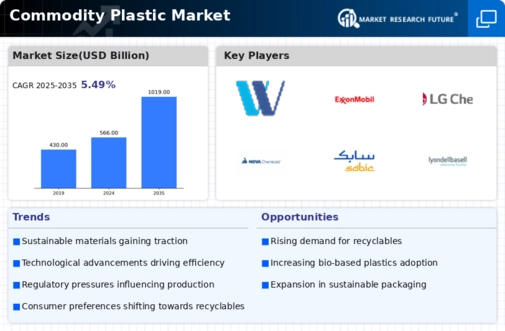Market Share
Commodity Plastic Market Share Analysis
In the highly competitive commodity plastic market, companies utilize a variety of strategies to establish and enhance their market share. These strategies encompass technological innovation, strategic partnerships, geographical expansion, pricing tactics, sustainability initiatives, and robust marketing endeavors. Each of these elements plays a crucial role in enabling companies to differentiate themselves, attract customers, and gain a competitive edge in the commodity plastic segment.
Technological innovation stands as a cornerstone strategy in the commodity plastic market. Companies invest in research and development to develop new plastic formulations, manufacturing processes, and applications. Innovations may involve the creation of plastics with improved strength, flexibility, recyclability, or biodegradability, as well as the development of novel additives and compounds to enhance performance. By offering innovative solutions that meet evolving customer needs and regulatory requirements, companies can differentiate their products, attract new customers, and gain market share.
Strategic partnerships and collaborations are essential for companies seeking to strengthen their market position in the commodity plastic industry. Companies form alliances with raw material suppliers, manufacturers, recyclers, and end-users to create value chains and supply networks. Collaborative efforts enable companies to access new markets, leverage complementary expertise and resources, and drive product development and innovation. Moreover, partnerships with key players across the value chain enhance brand visibility, credibility, and market reach, driving growth and market share expansion.
Geographical expansion serves as a strategic imperative for companies aiming to capitalize on growth opportunities in the global commodity plastic market. Establishing a presence in key regions, particularly emerging markets with growing industrialization and urbanization, enables companies to access new customers and distribution channels. Localized production facilities and distribution networks enhance supply chain efficiency, reduce transportation costs, and improve responsiveness to local market demands. By strategically expanding their footprint, companies can strengthen their market position, increase brand awareness, and capture market share in diverse geographic regions.
Pricing strategies play a critical role in shaping market share dynamics within the commodity plastic industry. Companies adopt competitive pricing tactics to attract price-sensitive customers and gain a foothold in the market. This may involve offering discounts, bulk pricing, or value-added services to incentivize purchase and foster brand loyalty. However, pricing strategies must be balanced with considerations of production costs, market demand, and competitive dynamics to ensure sustainable profitability. Companies often employ dynamic pricing models and strategic pricing adjustments to optimize revenue and market share performance.
Sustainability initiatives are gaining prominence as a strategic imperative for companies operating in the commodity plastic market. With increasing consumer awareness of environmental issues and regulatory pressure to reduce plastic waste, there is growing demand for sustainable plastic alternatives and recycling solutions. Companies invest in sustainable sourcing, production, and recycling technologies to minimize environmental impact and meet consumer expectations. By aligning with sustainability goals and addressing consumer preferences for eco-friendly products, companies can enhance brand reputation, attract environmentally conscious consumers, and gain a competitive advantage in the market.
Effective marketing and brand positioning are crucial for companies seeking to differentiate themselves and gain market share in the commodity plastic industry. Companies leverage targeted marketing campaigns, digital channels, and product labeling to communicate the quality, performance, and sustainability attributes of their plastic products. Building a strong brand identity based on reliability, innovation, and environmental responsibility helps companies stand out in a crowded market and resonate with consumers. Moreover, strategic branding initiatives enable companies to command premium pricing, strengthen customer loyalty, and reinforce market leadership position.
Customer service excellence is paramount in driving market share growth and sustaining long-term success in the commodity plastic market. Companies prioritize customer-centric practices, including responsive communication, product quality assurance, and prompt resolution of inquiries or complaints. By consistently exceeding customer expectations and delivering superior value, companies can foster brand loyalty, generate positive word-of-mouth referrals, and gain market share traction. Furthermore, proactive engagement with customers enables companies to gather valuable feedback, identify emerging trends, and adapt their strategies to evolving consumer preferences and market dynamics.












Leave a Comment